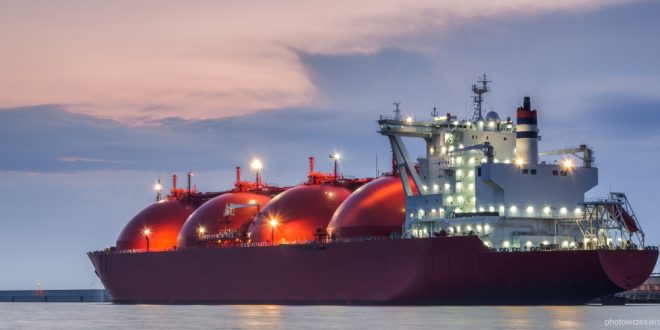Royal Dutch Shell and Russian state-controlled oil and gas company Gazprom concluded the first carbon-neutral LNG delivery in Europe, they said. It was also Gazprom’s first foray into the emerging carbon-neutral LNG segment. The LNG was delivered to Shell’s Dragon LNG import terminal at Waterston, Wales.
The move follows various countries, including the UK, pledging to reach net-zero emissions nationwide by decarbonizing energy supplies by 2050, while LNG suppliers attempt to decarbonize in line with customer goals.
Shell itself aims to reach net-zero emissions for its energy businesses by 2050. Its plan for transitioning to net zero while still producing fossil fuels revolves around nature-based solutions that offset emissions, and access to carbon capture, utilization, and storage projects such as the Quest project in Canada. Shell sells nature-based carbon credits to offset carbon dioxide (CO2) emissions of its fuel-station clients in the UK and the Netherlands.
Shell has in the past relied upon projects using the Verified Carbon Standard (VCS), which has been the most frequently cited standard for carbon-neutral LNG offsets to date, but Shell’s portfolio of carbon offsets also features credits from other registries and standards.
The companies’ LNG transaction also comes against the backdrop of American sanctions that have delayed Gazprom’s completion of a pipeline bringing natural gas to Europe, Nord Stream II.
LNG delivery
Ensuring the LNG is carbon-neutral, Shell inked a transacted with an unnamed entity to ensure third-party verified, nature-based projects absorbed enough CO2 emissions to offset the LNG’s full lifecycle emissions. It obtained 240,000 metric tons of CO2-equivalent reductions, either from nature-based processes, or avoided deforestation.
To calculate the amount of CO2e offsets needed, Shell used the UK government’s Department for Environment, Food and Rural Affairs conversion rates.
Prior to bringing the carbon-neutral LNG to Europe, Shell pioneered meeting demand for spot carbon-neutral LNG cargoes in Asia. “We have already delivered seven carbon-neutral cargoes in Asia and are very excited to be able to now offer this to customers in the UK,” Shell Energy Executive Vice President Steve Hill said in a statement.
Carbon-neutral LNG markets
According to IHS Markit’s official tally, only eight carbon-neutral LNG cargoes have been delivered worldwide to date, but more have likely been traded on the market. While French major Total also supplies carbon-neutral LNG, Shell remains the leader in the space over the past two years, according to IHS Markit’s carbon-neutral and low-emissions LNG report.
“Although challenges remain for building out a robust carbon-neutral LNG market, IHS Markit expects announcements of these cargoes to increase in the near term,” wrote IHS Markit Senior Analyst Jason DuPaul in the report.
Japan has become a buyer of carbon-neutral LNG since it set the goal of becoming a net-zero emissions country by 2050. It was the world’s largest LNG importer in 2019.
Japan’s energy supply coordinator JOGMEC and companies it works with are now trying to reach carbon neutrality, its Chairman and CEO Tesuhiro Hosono told audiences at the recent CERAWeek by IHSMarkit event.
Japanese natural gas utility Tokyo Gas and South Korean LNG terminal operator GS Energy bought the first carbon-neutral LNG cargoes from Shell in 2019. The Japanese utility has since used carbon-neutral LNG to achieve its net-zero goals by suppling of carbon-neutral city gas to factories, office complexes, and a hotel.
Elsewhere in Asia, Taiwanese petrochemical company CPC took delivery of carbon-neutral LNG from Shell in March, and Chinese state-controlled importer CNOOC agreed to buy carbon-neutral LNG from Shell in June.
A joint fuel-procurement venture between Japan’s Tokyo Electric Power and Chubu Electric Power, JERA, also supplied a carbon-neutral LNG cargo to India. Unlike many of Shell’s, JERA’s cargo only offset downstream carbon emissions.
Action on decarbonizing LNG is also coming from the producer side of the equation. In February, American LNG supplier Cheniere Energy said it would begin to disclose the carbon emissions of its LNG on a per-cargo basis in 2022. Cheniere aims to cut the carbon intensity of its LNG production.
Targeting net-zero emissions, French major Total is also considering piloting a fully electrified LNG plant in Oman to reduce the fuel’s greenhouse gas emissions, according to an IHS Markit technical report.

LNG TANKER - Ship at dawn moored to the gas terminal
 Iran Energy News Oil, Gas, Petrochemical and Energy Field Specialized Channel
Iran Energy News Oil, Gas, Petrochemical and Energy Field Specialized Channel



